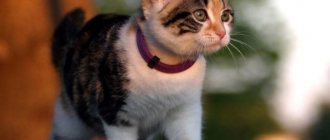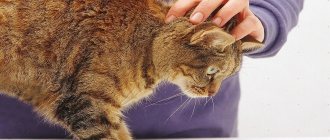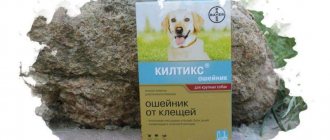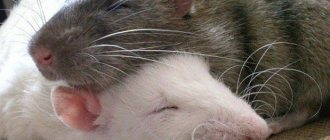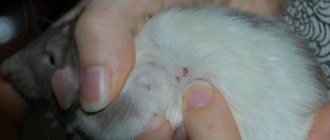Dangers of flea infestation
Fleas, like any other parasites, pose a great threat to your pet's health. They parasitize on a cat’s body with incredible speed: the female is capable of laying up to 8 eggs in one clutch, and during her life the number of larvae laid exceeds 2 thousand. One of the features of flea development is that it does not occur on the animal’s body, but on surrounding objects. The larvae grow where the eggs were originally laid.
The first days of the disease
It is almost impossible to determine the disease in the first days; even the most attentive owner may not notice slight deviations in the cat’s behavior that indicate some kind of problem. The habits of a furry pet practically do not change; you can suspect something is wrong only by more frequent scratching. Also, a good way to find fleas during this period is to check the cat's tummy. Existing black or dark red dots indicate that the pet’s blood has been digested and secreted by parasites.
Second stage of infection
After some time, the number of fleas reaches 200 individuals. The cat's behavior changes dramatically, she:
- becomes restless;
- constantly combs itself and bites itself in places where fleas accumulate;
- refuses favorite food;
- stops sleeping during the day;
- asks the owner for help in his own way (rubs his legs, asks to be held, often lies down next to him, etc.).
During this stage, fleas are easy to spot with the naked eye. It is enough to examine the fur - parasites will be clearly visible on it. Small bleeding wounds are visible on the skin.
If your cat brushes himself frequently, you might want to consider whether he has fleas.
Advanced form of the disease
The condition of a furry friend can reach critical levels when the pet experiences severe pain. Due to the large number of fleas at this stage, the following problems and diseases develop:
- allergic dermatitis;
- anemia due to constant blood loss;
- significant loss of body weight;
- hair loss in patches with the formation of bald spots.
Cats at this stage are very exhausted and helpless, they lose all interest in entertainment. Diseases caused by parasites can threaten their lives.
In what cases do veterinarians recommend using drops?
Veterinarians recommend choosing drops from a wide variety of anti-tick and flea treatments for cats in several cases:
- for treating young, active animals that find it difficult to sit still;
- cats that regularly go outside;
- animals that require not only protection, but also getting rid of existing insects.
At the withers
Since some types of drops, due to their combined composition, work not only against blood-sucking insects, but also against helminths, they are prescribed when both types of parasites are found in a pet. Due to the ease of application, the drops are best suited for pets who categorically do not accept bathing and have a negative attitude towards wearing a collar.
Flea remedies: how to choose and use
Currently, there are:
- shampoos,
- powders,
- drops,
- collars,
- sprays,
- injections,
- pills.
Shampoos
Most shampoos are based on chemicals: permethrin, deltamethrin, methionine and others. Various softening elements are used as additives to improve the condition of the coat and fight inflammation due to parasites. Eg:
- Extracts from medicinal herbs that help relieve inflammation and have a healing effect. They also eliminate itching and additionally repel fleas with their scent.
- Essential oils, which help the fur to recover, make it smooth and pliable to comb.
- Amino acids - added for rapid growth of new hair, as well as for recovery after treatment of dermatomycosis. These substances help restore the upper layer of the epidermis.
If fleas appear on a nursing cat, you should not bathe her with shampoo. In any case, its particles remain on the skin and fur. When feeding, they enter the body of newborn kittens and can cause significant harm to their fragile organs.
If a pregnant or lactating cat is infected with fleas, it is advisable to treat it with folk remedies.
Not everyone will like it, but it will help everyone: a bath with shampoo is one of the methods of treatment
Powders and powders
Powders and powders are an unfairly unpopular form of flea treatment for cats. If your cat is pregnant and has picked up parasites, one of the effective ways to remove them is to use these drugs.
Powders and various powders, after being applied to the cat’s skin, accumulate in the glands and epidermis. The accumulated substance from the bite enters the body of the parasite and causes disruption of the nervous system. The main active ingredient in the powders is karbofos or permethrin analogues. All powders have a fine-grained structure and are sprinkled onto the fur. After killing the fleas, you need to comb the cat with a special comb.
Sprinkling powders should be applied to clean and dry hair, otherwise the effect will not be achieved.
If necessary, some types of powders can be used to disinfect surfaces. To do this you need:
- sprinkle the product onto surrounding objects in contact with the cat,
- maintain the time specified in the instructions for the drug,
- collect the powder and clean the coatings.
In this case, there is one drawback: if there is a person in the house who is susceptible to chemicals, then he needs to leave the room during the disinfestation.
Drops on the withers
Drops on the withers have a number of advantages. They:
- easy to use,
- no need to calculate their dosage and prepare complex mixtures,
- provide maximum safety for the cat, as they are applied to places inaccessible to the cat (which means the risk of getting inside is minimized)
There are many products, but drops are the easiest to use
Flea drops contain insecticides that are characterized by rapid action and have relatively low toxicity. Some representatives of this type of preparation also combine an odor that is unpleasant for fleas, which, in turn, additionally protects cats from parasites. The following substances are most widely used in the composition:
- Invermectin is a drug based on the mechanism of disruption of the nervous system of parasites, leading to their paralysis. It has a strong toxic effect, so drugs containing this component must be taken strictly according to the instructions.
- Permethrin is an insecticidal agent that disrupts the polarization of the membrane of nerve cells. It does not harm the pet, even if it enters the gastrointestinal tract, as it has low toxicity and is easily excreted by the body.
- Fipronil is a modern broad-spectrum insecticide that affects the central nervous system of parasites. Does not have a pronounced toxic effect and is safe for pets.
Regardless of the composition of the drops and the indicated side effects, you need to monitor the cat’s condition after applying the product. Any changes should raise suspicion of an allergic reaction.
Basic principles of using drops:
- You cannot bathe your cat two days before using the product and for two days after.
- It is advisable to apply the drug in the evening, as it may lose effectiveness from sunlight.
- The drug is dripped onto the withers (closer to the base of the skull) so that the pet cannot lick it off.
- If the instructions say to apply the product along the spine, then you do not need to go below the middle of the body. This restriction is imposed for the same purpose - to protect the pet.
Sprays
Flea sprays for cats should be as safe as possible (there is a possibility of the product being ingested through the respiratory tract) and effective. In order not to harm your pet, you need to spray the drug as carefully as possible, without getting it on the mucous membranes and muzzle in general. It is better to carry out processing in a ventilated area. Also, to ensure the safety of the cat, you need to take into account its age and condition of the skin, otherwise the drug may penetrate inside and cause poisoning.
The use of flea spray on kittens under 3 months of age is contraindicated.
After applying the spray to the fur, make sure that the cat does not lick itself for the time specified in the instructions for the product. To do this, you can put a special collar on his neck. After the specified period of pest-baiting, your furry friend needs to be washed.
Collars
A collar on a cat, as a rule, indicates belonging to the home and care from the owners. At the same time, the product is practical and convenient to use. The undoubted advantages of this flea protection product are its simplicity and reliability. The use of collars does not provide for additional methods of protection (use of sprays, shampoos).
There are several types of collars:
- Collars containing active chemicals.
- Ultrasonic collars designed to prevent the appearance of fleas (they operate on batteries and scare off potential “neighbors” with ultrasound).
- Biological collars consisting of herbs and essential oils. They act similarly to ultrasonic ones, but have an unpleasant odor that may not be to the cat’s taste.
After purchasing a collar, you need to monitor the condition of your pet’s skin in order to notice in time an allergic reaction to a chemical or herbal component.
An antiparasitic collar, like any other product, has its own expiration date. Repellent types are limited to two or three months, but insecticide-impregnated collars can last six months.
Injections
Flea injections are not prescribed or recommended for all sick cats. You should resort to this method if other drugs do not have a positive effect and the pet’s condition is close to critical. The procedure is also indicated in case of helminthic infestation due to flea infestation. Injections have a more pronounced effect compared to other means, so it is not advisable to use them for mild forms or for preventive purposes.
The advantages of injection therapy in the fight against fleas are as follows:
- Ease of use. The drug is injected at the veterinary clinic into the back of the shoulder. The cat does not feel pain at this moment.
- Reliability. The administered substance has a detrimental effect on all types of parasites.
- Quick effect. The injection begins to act immediately after administration, the drug spreads through the bloodstream and gets inside with each flea bite.
- The components of the drug have a destructive effect even on flea eggs.
Although a flea injection is painful, it is more likely to help your cat.
Injections are intended for adult cats; under no circumstances should injections be given to kittens, pregnant or lactating females.
Any injection contains one of three substances:
- invermectin, which is an antiparasitic drug that affects the transmission of nerve impulses (thanks to it, paralysis occurs in the parasite);
- eprimek (also causes paralysis and death of fleas);
- lufenuron, which prevents the formation of chitin - the main element of the flea shell - due to which the larvae cannot develop. It has no effect on adults.
Pills
The advantages of tablets are:
- painless compared to injections,
- relatively low risk of adverse reactions,
- no discomfort in the pet.
The tablet, once in the stomach, dissolves under the influence of juice, then is absorbed into the blood and distributed throughout the body. Fleas feed on blood that is “poisoned” for them. The drug affects their nervous system, causing further paralysis.
For greater effectiveness, it is recommended to use shampoos and/or thorough combing with special combs.
Before purchasing tablets, you should read the instructions and consult with a specialist. After taking the medicine, you need to monitor your pet's condition. This form of the drug cannot cause poisoning, but allergic reactions to some components occur.
Table: advantages and disadvantages of flea control products
| View | Advantages | Flaws |
| Shampoos | Clinical studies have proven that they are effective and safe, including for kittens. High-quality and natural shampoos do not irritate mucous membranes and skin. The line includes samples that help restore wool, as well as eliminate unpleasant odors. | Not everyone can afford high-quality shampoos. Cheap samples do not always cope with the task and consist of 80% water and various thickeners. |
| Powders | The powders have proven themselves to be the best; they effectively fight both adult individuals and their larvae. Some preparations are also intended for application to surfaces. | Powders differ from other products in the difficulty of dilution. When using some products, it is necessary to resort to individual protective measures, and after treating the room, ventilate it. |
| Drops on the withers | An undoubted advantage is their ease of use. The drops have a toxic effect only on parasites and do not harm the pet. They are used for both medicinal and prophylactic purposes. When using drops on the withers, the result comes much faster. | There are individual forms of intolerance to the drug. The drops require strict adherence to the instructions, taking into account all side effects. |
| Sprays | Sprays have a powerful insecticidal effect. One application in severe cases is sufficient. | Strong toxic effect, it is necessary to take precautions and strictly follow the instructions. |
| Collars | Collars have a big advantage - the pet will not bring parasites from a walk. They help prevent fleas from appearing on the animal. | The appearance of an allergic reaction due to individual intolerance to the drug contained in the collar. It does not destroy laid eggs or adults. |
| Injections | The injections are easy to use. The duration of action varies from 1 month to six months depending on the drug used. They affect all fleas, no matter whether it is a larva or an adult. | Individual intolerance to the drug occurs, or side effects occur. Some injections should not be given to small kittens or pregnant cats. |
| Pills | The tablet form of the drug does not cause pain or discomfort. The drugs do not cause irritating reactions. They are an effective way to control fleas. | Flea tablets are quite expensive and often need to be ordered directly from the manufacturer. Cheap analogues do not always cope with the task. |
Collars
They should only be used imported (Foresto, Kiltix, Scalibor). They do not have strong odors, are used for a long time (from 3 months or more), you can swim with them and not worry about a decrease in efficiency. The total cost of such a collar may be somewhat shocking (generally, the price of collars is over 1,500 rubles), however, when recalculating the amount for a month of use, it comes out even cheaper than the monthly use of good sprays or pipettes.
The main advantage is that, having put on the collar once, you forget about external treatments for a long time (you only need to pull the collar to the sides once every 2-3 weeks in order for the active substance to be released). But there are also disadvantages - the product is not suitable for hairless animals, continuous wearing is required for the entire period of action, it begins to work effectively on the 5-7th day of use (i.e. for this period it is worth limiting the animal from walking or using additional means of protection).
Effective folk remedies
Often, when faced with fleas on a cat, the first thing an owner decides to do is deal with this problem on their own. In this case, folk remedies come to his aid.
The most popular are baths with the addition of essential oils. They not only help get rid of fleas, but also restore the pet’s fur. For additional protection, you can treat pine sawdust used as bedding with essential oils or special extracts. This aroma not only calms your pet, but also repels parasites.
Video: treating kittens for fleas
Using tar soap helps get rid of fleas in 3-4 days, but not with advanced forms of the disease. The product also promotes wound healing. To treat a cat, you need to whip up the soap and apply it liberally to the fur. Then you need to wait 5 minutes and rinse thoroughly with warm water. After drying, you need to comb the cat.
What should be included in a quality shampoo?
Flea shampoo for kittens and cats must contain active additives. For example, permethrin. The product also contains natural substances (essential oils, extracts and decoctions of plants). The composition also contains safe minor substances. These include aromatic additives and dyes. The auxiliary substance is a soap base.
Each product manufacturer, of course, has a rating. It is influenced by the quality of the product, reviews of consumers and regulatory authorities. It shows the degree of safety, efficiency and reliability. This is the most important criterion that will be needed when choosing a detergent.
Tips for choosing the right product
To choose the right drug, many factors must be taken into account. If the degree of the disease is low and the number of fleas is small, then you should not resort to injections and powerful tablets. It is enough to limit yourself to folk remedies and shampoos, and after baths you must definitely comb the cat.
If the disease develops or more gentle remedies do not help, you should first consult a specialist. The choice of drug depends on the cat’s condition: the more severe it is, the more aggressive the treatment is prescribed (high-quality drugs will be expensive). Malnourished animals are not given most injections and toxic substances, as are pregnant cats. If a kitten under 3 months of age is sick, you cannot treat it yourself. Most medications are contraindicated for him.
What to use from three months of age
Most anti-flea medications can be used to treat fleas in kittens over 12 weeks of age. There are only weight restrictions - the body weight of the animal must be at least 1 kg.
Veterinarians advise starting anthelmintic therapy a few days after treating the wool with insecticides. Few people know that fleas are potential carriers of helminthiasis.
The range of products available on the veterinary market is varied, but in no case should you use drugs intended for the treatment of head lice and other parasitic infestations in humans.
How to prevent infection
Avoiding flea infestation is very easy. To do this, you need to periodically comb the cat and bathe it in the bath with special shampoos. If he does not tolerate water, then wearing a collar with special deterrents will be a reliable remedy.
Regular brushing of your cat helps prevent fleas
Keeping your home clean is also an integral part of preventing infestation. If a cat has once been exposed to fleas, then there is a possibility that their eggs will be found on the surfaces of the room. If you do not clean up with sufficient regularity, the developing larvae can again end up on the cat's fur, and the whole thing will happen again.
Advantages and disadvantages of using anti-flea shampoo
The undoubted advantages of liquid flea products include:
- versatility - suitable for cats of all breeds;
- low toxicity;
- ease of use;
- efficiency - fleas die on the second day maximum;
- low cost;
- no side effects;
- positive effect on wool quality.
The disadvantages include the following:
- the possibility of allergic reactions to some components;
- short period of protection (no more than 20 days);
- cheap products are ineffective, and high-quality shampoos are much more expensive;
- Some cats cannot stand water treatments, so shampoo cannot be used.
If our cat suddenly has fleas, we always wash her first with a special anti-flea shampoo, and then put on a protective collar to avoid re-infestation.
Description of the main groups of insecticides
All drops against fleas and ticks can be divided into two groups:
- repellents , that is, preparations that repel insects, made on the basis of natural ingredients, for example, essential oils of lavender, wormwood, eucalyptus, geranium, mint, are most often used for protection;
- insecticides – destroying parasites using pesticides included in the preparation.
In turn, insecticidal preparations according to the principle of action are divided into two categories:
- contact – distributed over the skin and affects insects upon contact;
- systemic - they begin to act when they enter the parasite’s body with the animal’s blood at the time of the bite.
Depending on what insects the drug is aimed at, it can be:
- insecticidal (against lice, fleas, lice);
- acaricidal (against ticks);
- insectoacaricidal (against insects and ticks).
To understand what effect to expect from a particular drug, you need to focus on which group of drugs it belongs to.
Rules for using drops
When using drops against fleas and ticks for cats, you must follow some rules:
- do not wash your pet a couple of days before the procedure and 2-3 days after it;
- Apply drops only to dry, intact skin;
- apply the product directly to the skin, and not to the coat; to do this, the undercoat is parted and the nose of the pipette is placed directly against the skin;
- The best place to apply flea drops is at the withers (on the back of the neck at the base of the skull).
Following these recommendations will allow you to get the maximum effect from the medicine.
Precautionary measures
Recommendations for the use of drops that will help avoid unpleasant consequences and complications:
- comply with the restrictions on the use of the drug specified in the instructions;
- strictly follow the dosage (this is especially important when applying anti-flea drops to kittens);
- do not allow the drug to come into contact with mucous membranes or in the mouth;
- Do not pet the animal for 24 hours after treatment; during this time, limit its contact with other pets.
No ironing
The procedure must be carried out with gloves, and if you are prone to allergies, wear a mask. After treating your pet, throw away the gloves, mask and pipette, and wash your hands thoroughly.
Can dog medications be used to protect cats?
To treat and prevent fleas or ticks in cats, do not use drops intended for dogs or puppies. Most often, products for dogs contain a higher concentration of the active substance, which can be dangerous for the cat.
Attention! The main component of many drugs for dogs are compounds that pose a mortal threat to cat health. A striking example is permethrin. A cat can be poisoned by dog drops based on this substance, even if they were used to treat a dog living in the house.
To avoid unpleasant consequences, you should follow a simple rule - carefully study the instructions for the medicine. If it states that the drops are approved for the treatment of dogs and cats, then they can be applied to both (naturally adjusting the dose). If there is no indication of cats in the instructions, it is not worth the risk.

